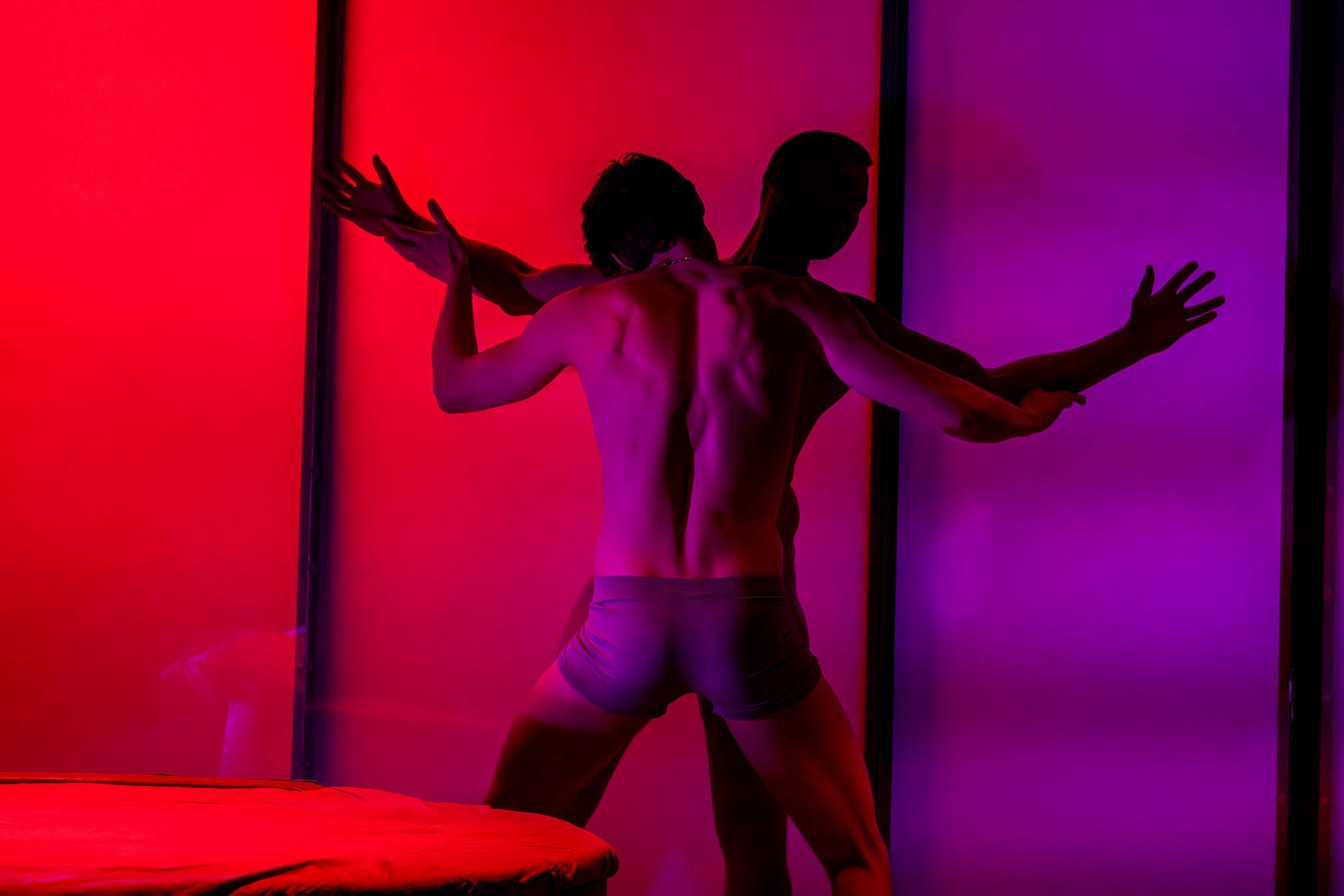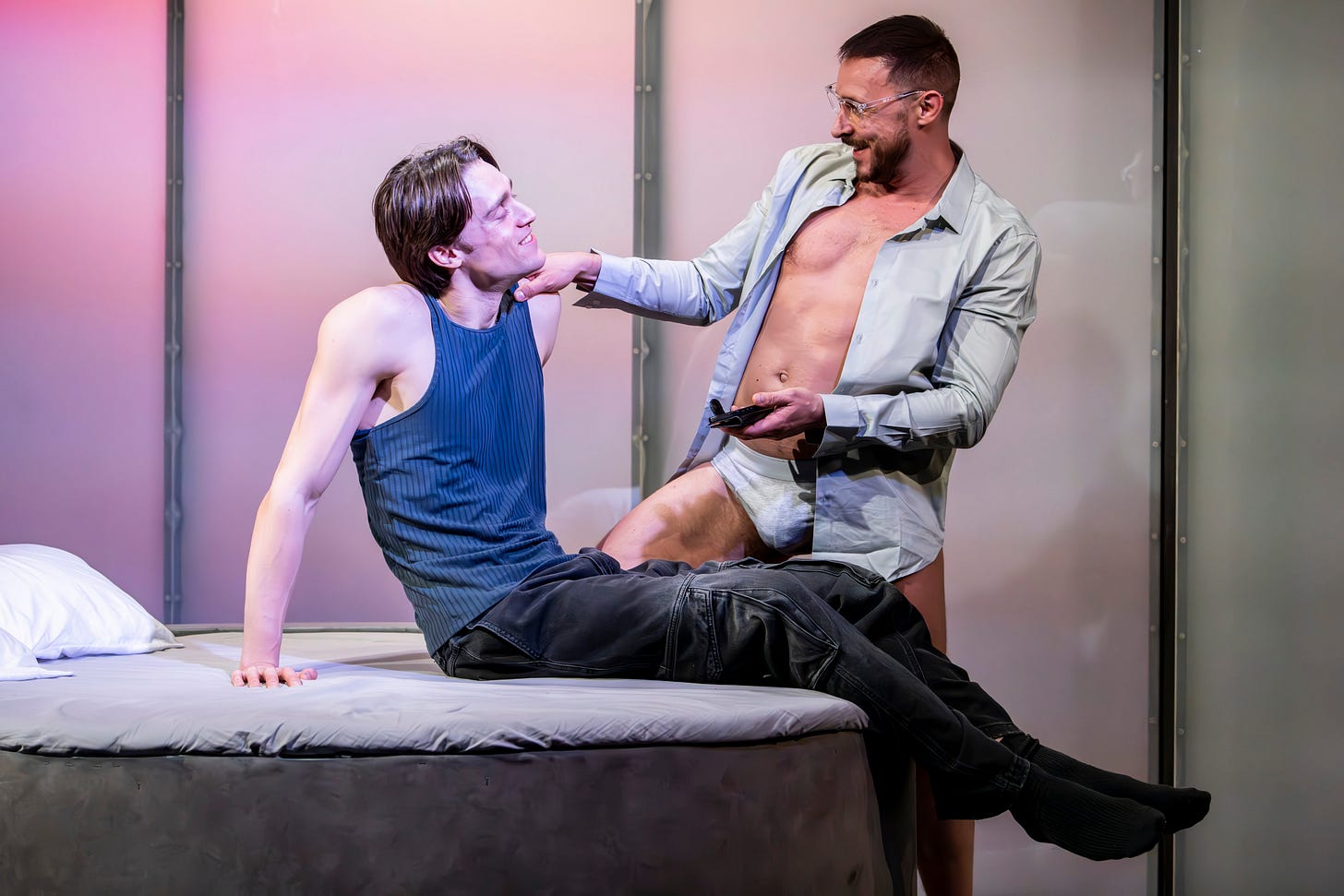First it caused riots. Then it was censored. Now we can't stop rewriting it.
As F**king Men returns, Holly Williams explores why La Ronde's sexual daisy-chain is still so irresistible
By Holly Williams
Underneath a railway arch in Waterloo, men are fucking – again. Joe DiPietro’s F**king Men is set in a contemporary New York and unfolds over ten scenes of ten sexual encounters between ten men – the last eventually meeting the first to form a perfect daisy-chain of hook-ups. This is far from the first outing for F**king Men, which has become a remarkably bankable British fringe theatre staple: it opened in 2008 at The Finborough, and was revived at The King’s Head within a year – a run so popular, it was twice extended, wining it the accolade of “London’s longest-running fringe show”. It was revived at the same theatre in 2015; again extending, touring, transferring, and selling out everywhere. This current production, by director Steven Kunis, once more repeats the success story: first staged at the Waterloo East Theatre in 2023, this is its third consecutive year at the same venue, the poster proudly declaring ‘back by popular demand’. F**king Men just keeps coming back around.
But there are more circles within circles here. F**king Men is an adaptation of another play – Arthur Schnitzler’s La Ronde. Written in 1897, it established that ten couples/ten sexual encounters structure, although it was written about the hypocrisies and hopes, the game-playing and the genuine bids for connection between heterosexual couplings in fin de siècle Vienna rather than gay ones in 21st century America. Yet even the name La Ronde – the round, or the roundelay – is a spin: Schnitzler originally wrote the play in German, and it was called Reigen, a dance in the round. La Ronde was the French title of probably the most famous adaptation, Max Ophüls’ lush 1950 film.
It’s had competition, mind: despite Schnitzler’s play initially being deemed so shocking it was banned in Vienna (on which more later), it has long inspired a seemingly endless carousel of re-writes, riffs, and re-imaginings. There have been many theatre and film versions, as well as ballets, musicals, TV shows, operas, and a flamenco show. In 1956, Gene Kelly borrowed La Ronde’s structure for his dialogue-free dance movie, An Invitation to Dance. In 1993, Michael John LaChiusa’s musical version Hello Again kept the structure but skipped around in time, so that one scene took place on the actual Titanic. In 2011, Peter Morgan’s also hopped between cities in his portmanteau thriller 360, starring Anthony Hopkins and Rachel Weisz. And in 2017, a gender-fluid update by Max Gill at the Bunker Theatre boasted different casting each night, decided by a Wheel of Fortune style spinner, with 3,000 potential different versions.
F**king Men, then, is merely the most recent example of how eternally appealing that seemingly rigid structure is – and indicative of its true elastic potential. La Ronde is very much a writers’ play, suggests Di Pietro. “Ten people, ten scenes, people hopping in and out of bed without ever seeing the sex… I always thought was a fascinating, fascinating structure,” he tells me, on a zoom call from New York.
I also have skin in this game: I, too, think it’s a fascinating structure. An irresistible one. Such an irresistible one, in fact, that I wrote a whole novel based on it. The Start of Something, published by Orion last year, has ten chapters, ten characters, ten sex scenes, but is updated to the present – using Schnitzler’s form as the frame for looking at sex and intimacy in a modern, atomised world. So I’ve been fascinated to see F**king Men keep returning to Waterloo East, over the years I was editing and publishing the book. Clearly, this story – or at the very least, this structure – still clicks with us today.
***
It’s something of a cliché to say that constraints can be freeing for writers – but it’s a cliché because it’s true. This is surely partly why updates and new perspectives on preexisting classics are so popular (that and the lazy wins of name recognition). Give us limits to play within, and they can fire up the creative, juicy, problem-solving part of the brain in more fruitful ways than the terrifying blankness of the empty page, the ‘write anything’ expanse.
So it was for DiPietro, who never planned to stage a gay La Ronde; he just started it as a writing exercise. And as I nerd out with him over all things Schintzlerish, we discover we were actually both inspired to riff on La Ronde via another riff (wheels within wheels) – David Hare’s sleekly updated 1998 version, The Blue Room. Yes, the one directed by Sam Mendes starring Iain Glen and Nicole Kidman – and one of very few shows best remembered because of a review: Charles Spencer in The Telegraph famously calling Kidman getting her kit off “pure theatrical Viagra”. I was possibly too young to know what the Donmar or indeed Viagra were in 1998, but read the script later as a student. Seed planted. DiPietro was too many thousands of miles away in 1998 to see it – but read Hare’s playtext too. Another seed planted.

Around that time, he would holiday in Provincetown in Cape Cod every year: “It was an artists’ colony, meaning it also became very much a gay resort. And I was fascinated by how gay men, um… the dance of it! And how that was so different from my straight friends, and how they interact,” he says, laughing at his own euphemisms. Seed watered: all-male La Ronde. “I literally thought: this will be an interesting writing challenge.”
It was pretty different to his more commercially-minded output, such as the long-running musical I Love You, You’re Perfect, Now Change, or the Tony-winning Memphis. When DiPietro first started working on F**king Men, the climate was rather different for “gay men talking very frankly about sex and intimacy,” he suggests, although he thinks the honesty and lack of judgement has ultimately been the key to its appeal. F**king Men begins with a soldier and a sex worker, and moves through hook-ups and open relationships, porn stars seeking affection and closeted Hollywood stars abusing their power. Characters are broadly sex positive, to use a term that wasn’t around when he wrote it, and express their sexual desires with unabashed directness; it’s their yearning for emotional connection that can’t always be spoken. As a review of Kunis’s production in Attitude magazine said, “The only coy thing about the revival of Joe DiPietro’s F**king Men is the asterisks in the title. It’s unapologetically frank about gay sex.”
It turned out, there was an appetite for “unapologetically frank” writing about gay sex in the late 2000s – in the UK, at least, with F**king Men almost immediately picked up. “The Finborough did a reading and then said can we do this two months from now. I don’t know why, but it really hit a nerve in the UK,” observes Di Pietro. “It’s never been done in New York. Americans are more prudish in certain ways…”
And prudishness has always dogged La Ronde. Schnitzler’s text scandalised Viennese society when it was first published in 1903; it was deemed shocking to write about sex and adultery so openly. Nonetheless, Reigen sold 40,000 copies – until it was banned, with booksellers prosecuted for selling pornography. The play was not given a full production until December 1920, in Berlin, and even then, it caused such an outcry that protestors stormed the theatre, with the cast, director and theatre management taken to court for public indecency. A production in Vienna in February 1921 was repeatedly interrupted by violent protests, whipped-up by a right-wing press; one night, a mob of 600 tore apart the theatre, and police banned all further performances.
Still, one person’s scandal is another’s delicious intrigue. La Ronde was a little better received at a private performance by the Bloomsbury Group in 1923 – even if it did prompt Virginia Woolf to observe that “the audience felt simply as if a real copulation were going on in the room and tried to talk to drown the very realistic groans…” It’s reputation was ultimately rescued by – where else – France, where two of the best-known film versions would ultimately come from: Max Ophüls’ delightfully comic, suavely knowing 1950 version, with Anton Walbrook as a ringmaster on a carousel setting the lovers in motion, and Roger Vadim’s 1964 movie Circle of Love, which – prefiguring the Kidman kerfuffle – caused a stir because Jane Fonda got naked. In yet another turn of the wheel, Vadim was threatened with obscenity charges in Italy when the film came out.
***
It would be wrong, however, to think of La Ronde as just about rude bits and body parts: Schnitzler’s original just puts mid-scene asterisks for where the sex act itself would be. Different adaptors have reached for different approaches as to what to do with those caesuras. Mendes used surtitles to indicate how much time passed; DiPietro brings in another character to speak over it; in Alexandra Wood’s version Unbroken, director Natalie Abrahami used dance to artfully depict the shagging. In my book, with no real-life bodies to have to worry about, I got to be explicit… but focused on trying to describe the internal, subjective experience of sex – where thoughts went, as much as where a body parts went.
Because La Ronde is obviously not, despite what some early detractors claimed, mere pornography. It’s not just about the sexual act itself or the negotiations around it, but also about what sex can tell us about power, class, gender, love, insecurity, and the need for human connection. That’s why Schnitzler’s structure appeals to writers, or at least why it appealed to me: yes, it’s fun to write the moment when desire ignites or takes over, characters hurtling towards a joyful coupling or a terrible mistake. But writing about sex is also a great way to crack open a character: an exposing, high-stakes, vulnerable act. And while sex is great shortcut for zooming in on character’s innermost hopes and fears, it also allows you to zoom out to reflect on what kind of society we’re live in, what that society is preoccupied with, what lies it tells about itself.
Schnitzler knew this. And his original is ghosted by a big, if unspoken, terror: syphilis. The idea that intimacy and pleasure could come at a terrible cost is one that has also, naturally, been seized on by adaptors. F**king Men was originally explicitly shot through with anxiety about HIV. But DiPietro has updated the play slightly each time it’s revived, to reflect its moment; this F**king Men is in a post-MeToo, post-dating app, and also post-PrEP world. “In earlier versions there was more about safe sex versus non safe sex, but that’s something that has changed,” says DiPietro. Something similar also changed in The Start of Something: originally, it was set in summer 2021 and animated by the idea of craving touch and connection while also being afraid of that, as we emerged from lockdown. But my editor was firm: no-one wanted to read about Covid. I suspect she was right, and all mention was excised – but I also suspect we’ll see a covid La Ronde, one day…

The other thing writers tend to be itching to update is the gender politics. Yes, Schnitzler plucks characters from across society, writing a variety of professions and background. “I love how it moves through society – with sex the great equaliser”, observes DiPietro, and most adaptors retain this class-straddling quality, the power play. But Schnitzler’s ‘dance’ is also almost always men try to persuade women to sleep with them – a dynamic which made sense in 19th century Vienna, when the societal penalty and physical risk for women sleeping around was so much higher than for men, even if both genders desired it. But such negotiations can feel repetitive, and less relevant, today – and one of the fun things about contemporary updates to La Ronde is how they wrangle different relationships structures, sexualities, gender identities, and kinks.
This was the fluid impulse behind Gill’s version at The Bunker, while a 2017 movie version of Hello Again switched up the musical’s genders with a male sex worker, a female politician, and queered relationships. In The Start of Something, I included a polyamorous non-binary poet, a bisexual drag queen, a pansexual teenager, a woman exploring BDSM… and don’t worry, a straight middle-aged white dude too. In F**king Men, the idea that gay men are “much more likely to have open relationships or multiple partners” was really the spur for the all-male re-write. “One sexual encounter isn’t going to necessarily derail their main relationship in the way that it might with heterosexual couples. I thought that was a really exciting thing to explore,” says DiPietro.
La Ronde has such a clear form, it can feel almost too cute: schematic, implausible in its orderliness. As David Hare observes in the introduction to The Blue Room, “over the years audiences have continued to argue whether the sexual daisy-chain [is] profound or over-neat”. And yet it is this neatness that also gives it the solidity which allows La Ronde to take whatever you throw at it, whether that’s the AIDS crisis or flamenco or even the sinking of the goddamn titanic. It will always offer a sturdy frame over which to drape contemporary anxieties about sex, power, and intimacy. “The circle structure is totally artificial,” DiPietro agrees. “But the math of it… it’s just so good.”
F**king Men is at Waterloo East Theatre, London to 4 May.
The Start of Something is out in paperback now.











